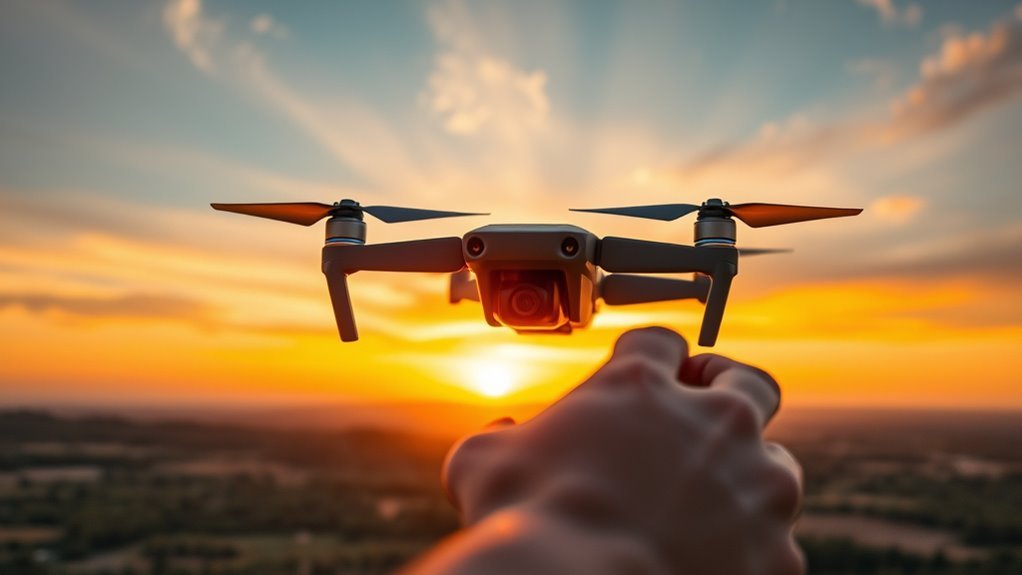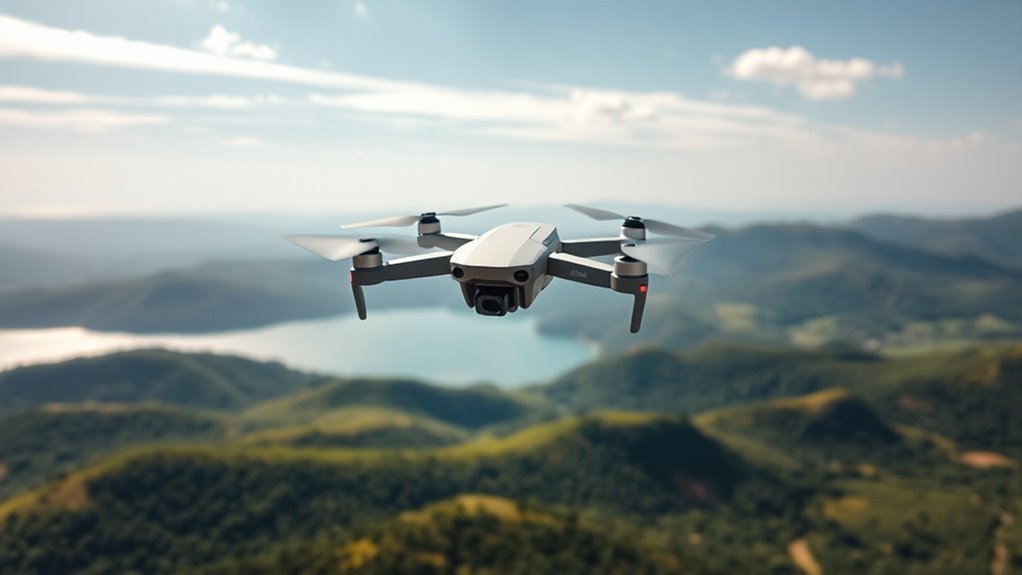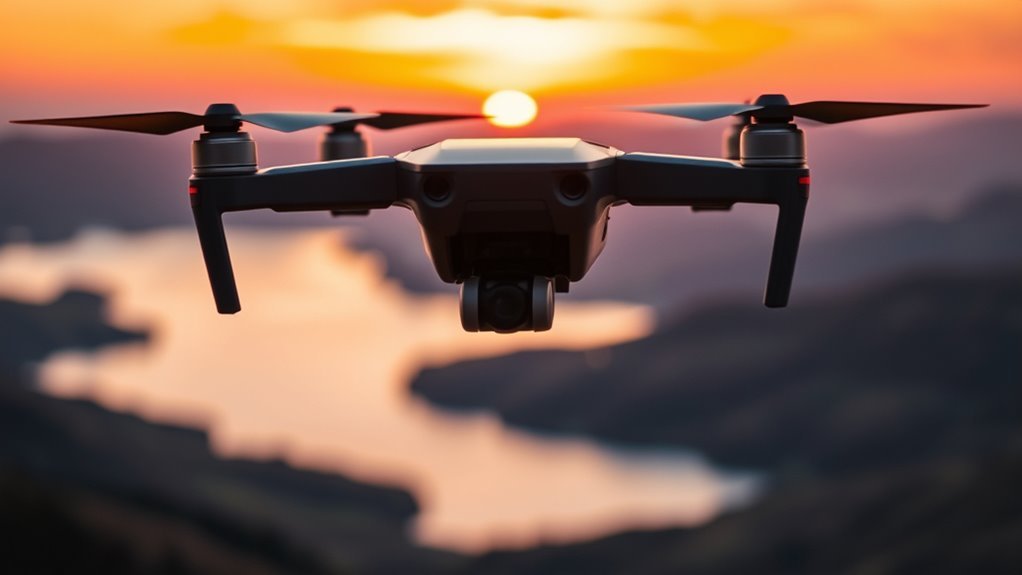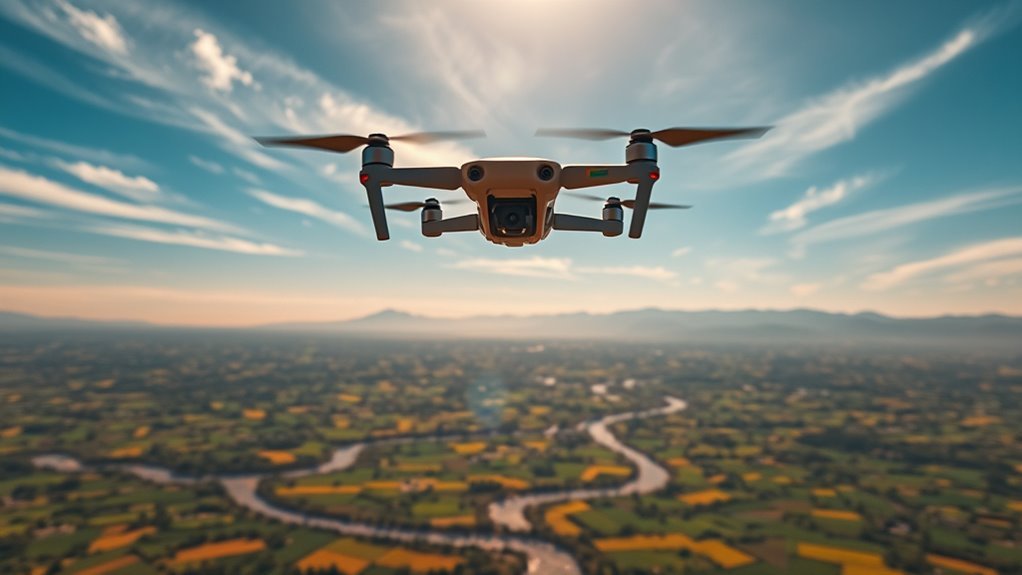If you’re considering the DJI Mini 2 SE, you’ll appreciate its compact, lightweight design under 250 grams, making it highly portable and easy to fly. It offers a 12MP camera with electronic stabilization and shoots smooth 2.7K video, delivering solid image quality for hobbyists. You’ll get up to 31 minutes of flight time, reliable wind resistance, and intelligent flight modes that simplify control. The price hits a sweet spot for beginners without many compromises. Explore further to understand how it stacks up against other models and real-world performance.
Design and Portability of the DJI Mini 2 SE

The DJI Mini 2 SE’s design emphasizes compactness and ease of transport, making it ideal for users who prioritize portability without sacrificing functionality. You’ll appreciate its compact design, which folds neatly into a small form factor, allowing you to carry it effortlessly wherever your adventures take you. Constructed with lightweight materials, the drone weighs under 250 grams, ensuring it won’t weigh you down or require registration in many regions. This lightweight build enhances your freedom to explore without logistical concerns. Additionally, the aerodynamic structure minimizes wind resistance, improving stability during flight despite its small size. The intuitive folding mechanism is durable yet simple, enabling quick setup and pack-up, so you can focus more on flying than on preparation. Overall, the Mini 2 SE’s design reflects a balance between portability and practical durability, making it a reliable companion for those who want to capture aerial moments without cumbersome gear.
Camera Quality and Video Performance

While weighing under 250 grams and maintaining a compact form, the DJI Mini 2 SE doesn’t compromise on camera quality and video performance. You’ll appreciate its 12MP sensor, which captures sharp, vibrant images with impressive detail. The drone’s electronic image stabilization greatly reduces shakiness, allowing smooth footage even in moderate wind conditions or during dynamic movements. This feature gives you the freedom to focus on creative shots without worrying about jittery video.
In terms of low light performance, the Mini 2 SE handles dusk or dawn scenarios reasonably well, though it’s not designed for extremely dim environments. Noise levels increase somewhat in lower light, but the results remain usable for casual to intermediate users. Video recording supports up to 2.7K resolution at 30fps, balancing clarity and file size effectively. Overall, the DJI Mini 2 SE delivers reliable, quality visuals that suit a variety of aerial photography needs without burdening you with heavy gear.
Flight Time and Battery Life

Beyond its impressive camera capabilities, the DJI Mini 2 SE also stands out regarding flight time and battery life, which directly impact how long you can capture those high-quality images and videos. The drone’s battery capacity is 2250 mAh, providing up to 31 minutes of flight time under ideal conditions, allowing you significant freedom to explore and record without frequent interruptions. Charging time is approximately 90 minutes, balancing downtime with efficient recharging. Understanding these metrics helps you plan your sessions effectively.
| Feature | Specification | Impact on Use |
|---|---|---|
| Battery Capacity | 2250 mAh | Extended flight time |
| Flight Time | Up to 31 mins | Longer recording span |
| Charging Time | ~90 mins | Moderate recharge wait |
| Weight | 249 grams | Portability without compromise |
| Power Efficiency | Optimized | Maximizes battery life |
This balance guarantees the Mini 2 SE fits your need for freedom during aerial capture.
User Experience and Ease of Use
Smooth operation and intuitive controls define the user experience of the DJI Mini 2 SE, making it accessible for both beginners and seasoned pilots. When you pick up the controller, you’ll notice the thoughtfully designed user interface simplifies complex functions without sacrificing versatility. This interface prioritizes clarity, allowing you to focus on capturing your surroundings rather than wrestling with menus. The drone’s beginner friendliness shines through automated flight modes and obstacle alerts, which help you maintain control while building confidence. Whether you’re launching your first flight or executing advanced maneuvers, the responsive controls provide a sense of freedom and mastery. Additionally, the compact design and straightforward setup reduce barriers to entry, letting you take off quickly and explore effortlessly. Overall, the DJI Mini 2 SE balances sophistication with simplicity, ensuring your experience is smooth, engaging, and empowering from the moment you power it on.
Stability and Wind Resistance
When you’re flying the DJI Mini 2 SE, you’ll notice its hovering accuracy plays an essential role in maintaining steady shots. Its wind handling performance is designed to counter moderate gusts, ensuring flight stability even in less-than-ideal conditions. Let’s examine how these features contribute to overall control and reliability during flight.
Hovering Accuracy
The DJI Mini 2 SE’s ability to maintain a steady position in the air is critical for capturing sharp images and stable video footage. When you operate this drone, you’ll notice its impressive hovering precision, which allows it to hold its spot with minimal drift. This altitude stability means the drone can maintain consistent height without sudden fluctuations, essential for smooth aerial shots. The Mini 2 SE employs advanced sensors and GPS to achieve this reliable hovering accuracy, giving you freedom to focus on framing your shots rather than constant adjustments. While it excels in calm conditions, its core strength lies in precise positional hold, ensuring your footage stays crisp. Overall, its controlled hovering makes it an excellent choice for users seeking dependable stability during flights.
Wind Handling Performance
Although the DJI Mini 2 SE is compact and lightweight, it demonstrates notable stability in moderate wind conditions, allowing you to maintain control without significant drift or erratic movements. Its wind resistance factors contribute to a reliable gust response, ensuring smoother handling during flight. When considering wind handling performance, keep in mind:
- Effective aerodynamic design reduces drag and improves stability
- Moderate weight balances portability with resistance to wind gusts
- Motor power adjusts swiftly to counteract sudden gusts
- Propeller efficiency supports consistent thrust in variable wind
- Real-time sensor data aids manual control under windy conditions
These elements combine to give you a confident flying experience, even when the breeze picks up, enabling you to explore freely without constant concern for wind interference.
Flight Stability Features
Because maintaining precise control during flight is essential, the DJI Mini 2 SE integrates advanced stability features designed to enhance both steadiness and wind resistance. Its flight stabilization technology actively counters external disturbances, enabling you to maneuver confidently even in breezy conditions. This responsive system works seamlessly with the drone’s lightweight frame, maintaining smooth trajectories without sacrificing agility. Complementing this, the gimbal performance guarantees your camera remains rock steady, delivering crisp, blur-free footage regardless of minor vibrations or wind gusts. For those who value freedom in aerial exploration, these stability features provide a reliable foundation, reducing the need for constant manual corrections. Ultimately, the DJI Mini 2 SE’s combination of flight stabilization technology and superior gimbal performance empowers you to focus more on creativity and less on compensating for environmental challenges.
Intelligent Flight Modes and Features
Intelligent flight modes on the DJI Mini 2 SE enhance your control and creativity by automating complex maneuvers and optimizing flight stability. These automated features allow you to focus on capturing stunning footage without worrying about manual piloting challenges. With intelligent flight, you gain access to precise, repeatable flight paths and cinematic shots that elevate your aerial photography.
Key intelligent flight modes include:
- QuickShots: Automatically execute predefined camera movements like Dronie and Circle.
- CineSmooth Mode: Slows down drone movements for smoother, cinematic footage.
- Waypoint Navigation: Lets you plot a flight path for the drone to follow autonomously.
- Altitude Hold: Maintains consistent height during flight for stable shots.
- Return to Home: Safely brings the drone back to its takeoff point with a single command.
These intelligent flight features deliver freedom, enabling you to explore creative possibilities confidently and efficiently.
Connectivity and Controller Performance
When flying the DJI Mini 2 SE, you’ll notice the controller maintains a solid range efficiency, allowing for extended operational distances. Signal stability is critical, and the drone’s connection remains consistent even in moderately challenging environments. Additionally, latency stays minimal, ensuring your commands translate into immediate responses for precise control.
Controller Range Efficiency
The DJI Mini 2 SE offers an impressive controller range that extends up to 6 kilometers under ideal conditions, allowing you to maintain a strong and stable connection with the drone. This range gives you the freedom to explore vast areas without worrying about losing control. However, understanding the controller features and range limitations is essential for maximizing your flying experience. Key considerations include:
- FCC and CE compliance affecting maximum range
- Environmental factors like buildings or trees impacting signal
- Battery life influencing controller and drone connectivity duration
- Use of enhanced transmission technology for extended reach
- Controller ergonomics designed for comfortable long-duration flights
Signal Stability Analysis
Beyond just range, maintaining a consistent and robust signal between your DJI Mini 2 SE and its controller is key to safe and responsive flying. In thorough range testing, the Mini 2 SE demonstrates strong connectivity, with minimal signal interference even in moderately congested environments. You’ll notice that the drone maintains steady communication up to its maximum advertised range, ensuring control commands are reliably received. However, signal interference can still occur near high-density Wi-Fi areas or metallic structures, so situational awareness is essential. The controller’s performance includes automatic frequency adjustments to mitigate interference, enhancing stability. This dependable connection gives you the freedom to explore confidently, knowing the drone won’t unexpectedly lose contact due to fluctuating signals during your flight.
Latency and Responsiveness
Although signal stability is essential, latency and responsiveness ultimately determine how effectively you can control the DJI Mini 2 SE in real time. A thorough latency analysis reveals minimal delay between your controller inputs and drone reactions, ensuring precise maneuverability. Responsiveness assessment highlights the drone’s quick adaptation to commands, crucial for capturing dynamic shots or maneuvering through complex environments. Key factors influencing your experience include:
- Controller-to-drone signal transmission speed
- Real-time video feed delay
- Processing time within the drone’s flight controller
- Environmental interference impacting responsiveness
- Firmware optimization for reduced latency
This combination grants you the freedom to pilot confidently, with near-instantaneous feedback essential for both beginners and experienced flyers seeking reliability in every flight.
Price and Value for Money
When considering the DJI Mini 2 SE, you’ll find its price point strategically set to attract both beginners and hobbyists without compromising essential drone features. The affordability analysis reveals that this model balances cost and capability, making it a compelling option for those mindful of budget considerations. You’re getting a lightweight, compact drone with reliable flight performance and decent camera quality, without the premium price tag. While it doesn’t include some advanced functionalities found in higher-end models, the Mini 2 SE offers solid value for its price, especially if you want a straightforward flying experience. For users seeking freedom in aerial photography and exploration without overspending, it provides an accessible entry point. Considering your investment, the Mini 2 SE represents a smart purchase that doesn’t sacrifice core features, aligning well with your desire for both affordability and reliable drone performance.
Comparison With Other DJI Mini Models
When comparing the DJI Mini 2 SE to other Mini models, you’ll notice subtle but important differences in camera quality, such as resolution and stabilization features. Flight time also varies slightly, impacting how long you can capture footage in one session. Understanding these distinctions helps you choose the model that best fits your specific needs.
Camera Quality Differences
Since capturing high-quality footage is a primary concern for drone users, understanding the camera capabilities of the DJI Mini 2 SE compared to other DJI Mini models is essential. When you evaluate the camera resolution comparison and low light performance, the Mini 2 SE offers solid specs but with some trade-offs. Consider these points:
- Mini 2 SE sports a 12MP sensor, matching the original Mini but less than the Mini 3 Pro’s 48MP.
- Video maxes out at 2.7K 30fps on the Mini 2 SE, while Mini 2 supports 4K 30fps.
- Low light performance is decent but not as refined as the Mini 3 Pro’s larger sensor.
- Mini 2 SE lacks advanced HDR and color profiles found in higher models.
- For casual freedom seekers, Mini 2 SE’s camera suffices, but pros might want more detail and dynamic range.
Flight Time Comparison
Among DJI’s Mini series, flight time is a critical factor that directly impacts your shooting sessions and overall experience. When you consider the Mini 2 SE, a flight duration analysis reveals it offers up to 31 minutes per battery charge. This is slightly less than the original Mini 2, which provides approximately 31 minutes, and the Mini 3, which extends up to 34 minutes. The battery efficiency comparison shows that while the Mini 2 SE maintains competitive power management, its lighter weight and simplified features contribute to optimized flight time without compromising portability. For you seeking freedom in the sky, understanding these differences helps balance your need for longer airborne moments against the drone’s size and capability. Ultimately, the Mini 2 SE offers a solid flight time suitable for most casual and semi-professional uses.
Pros and Cons From Real User Reviews
User feedback on the DJI Mini 2 SE Drone highlights a mix of strengths and weaknesses that can help you decide if it fits your needs. Many users praise its compact design features, which make it highly portable without sacrificing performance. However, some mention limitations in wind resistance during flight. Here’s a balanced overview based on real user reviews:
- Pros:
- Lightweight and easy to carry, ideal for spontaneous adventures
- Reliable camera quality for its price range
- Intuitive controls, great for beginners and experienced pilots alike
- Long flight time compared to other drones in the same category
- Quick setup and responsive app integration
- Cons:
- Struggles in strong wind conditions
- Limited obstacle avoidance sensors
- Some users report occasional connectivity drops

